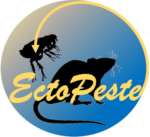Our work focuses on identifying and assessing the influence of the determinants of transmission to humans, predicting the risks of disease emergence or re-emergence, and proposing solutions to limit the health impact of these diseases.
They are part of an EcoHealth-One Health continuum, with the ambition of taking into account all the agents involved in the ecology of infectious diseases, including reservoirs, vectors, pathogens and the microbiome, as well as the environment and factors linked to human behaviour and practices.
Our main areas of research include France, West Africa and Madagascar.
Health ecology must be based first and foremost on the precise characterisation of infectious systems. To do this, we use integrative taxonomy and genomics approaches to identify the taxa that make up mammalian reservoir assemblages, their microbiome and some of their ectoparasite vectors of zoonotic agents, such as fleas. We are increasingly internalising molecular and serological tools to detect and characterise pathogens such as leptospires, trypanosomes, hantaviruses and schistosomes. In addition, we have developed considerable expertise in describing microbial compartments as a whole, whether pathogenic or commensal, using high-throughput sequencing approaches.
This work is most often carried out as part of spatio-temporal monitoring carried out in a variety of ecosystems: towns, agro-ecosystems, forests and natural habitats. This enables us to gain a better understanding of the impact of major anthropogenic upheavals (e.g. transport, urbanisation, forest management methods, ecological transition) on small mammal faunas and the associated zoonotic risks.
Our expertise in population genetics and genomics also enables us to describe the spatial structuring of reservoirs and vectors, infer their demographic dynamics and test biological invasion scenarios. To do this, we use approaches based on molecular markers such as microsatellite genotyping, sequencing and high-throughput genotyping, as well as innovative analytical approaches such as random forest, DIY-ABC and MAPPI.
It is now well established that pathogens evolve within diverse microbial communities, both commensal and pathogenic, on both intra- and inter-host scales. Describing the biotic environment of pathogens and their reservoirs is an essential prerequisite for studying the influence of interactions on the severity of diseases, as well as on their epidemiological and evolutionary dynamics. One of our aims is therefore to characterise the host-parasite-microbiota interaction networks in populations and natural communities of small mammals. To do this, we are developing approaches to study the stability, vulnerability or resilience of these interaction networks in the face of global change, and to identify the key elements in the transmission dynamics of pathogens.
Our research also aims to gain a better understanding of the ecological and evolutionary processes that shape host-pathogen interactions and explain the persistence, emergence and re-emergence of zoonoses. This work involves immunoecology and phylogenomics, population genomics and transcriptomics approaches, carried out on natural populations (or in controlled environments via collaborations). This involves, for example, assessing whether intra- and inter-host viral diversity affects the transmission of hantaviruses, or studying the variability of the host immune phenotype and its response (sensitivity, resistance or tolerance) to different pathogens (hantavirus; murine Plasmodium; Yersinia pestis). Here again, we are relying on the development of « omics » approaches to simultaneously analyse different immune pathways and characterise the genetic architecture of the response. This involves identifying the genetic characteristics of hosts and pathogens that are involved in virulence, particularly in the case of the Puumala hantavirus. We are also studying the evolution of this virulence, for example in the context of a change of host for Toxoplasma or murine Plasmodium, or a change in the small mammal community or microbiome for Puumala hantavirus.
As reservoirs, small mammals, particularly rodents, are an important target for controlling many zoonotic diseases affecting humans. Several of our projects are therefore aimed at proposing and evaluating strategies for managing these reservoirs in consultation with the various stakeholders, including international organisations, political and socio-economic players, local residents and at-risk groups.
For example, several ongoing projects in Europe and Africa aim to understand the risk of exposure of certain sections of the public to pathogens transmitted by small mammals. To do this, we are trying to determine the spatio-temporal distribution of zoonotic agents (e.g. Leptospira, hantavirus, Borrelia crocidurae, Yersinia pestis, Schistosoma spp.) on an ecosystem scale, in relation to socio-environmental factors (e.g. landscape, livestock farming, uses). These approaches enable us to map the risk over time and space (e.g. monitoring of the Puumala virus in France), to alert the health authorities (e.g. leptospirosis and hantavirus Seoul in Benin) and to direct surveillance accordingly (e.g. monitoring of the Hantavirus in the Netherlands). (e.g. setting up a port environmental monitoring platform in Benin) or control strategies – Ecologically-Based Rodent Management pilot project in Niger, Benin, Ethiopia and Madagascar).
To carry out all this work, we draw heavily on the expertise of our molecular biology, collections and IT technical platforms. We have also developed a vast network of collaborators in France, Europe and Africa, both academic (e.g. partner UMRs and universities, ANSES, Instituts Pasteur, WHO National Reference Centres) and operational (e.g. hospitals, companies, health-environment departments of various towns, ONF), political (e.g. ministries) or civil society (e.g. NGOs, participatory groups, associations).
Project manager: Nathalie Charbonnel
Funding : European union (HORIZON RIA, call HORIZON-CL6-2021-BIODIV-01-11)
The BEPREP project aims to identify ecological restoration strategies with mutual benefits for biodiversity and health, with a view to ultimately promoting ‘nature-based solutions’ as major tools for preventing zoonotic epidemics.
https://www.beprep-project.eu/

Project manager: Nathalie Charbonnel
Funding: BiodivERsA
The BioRodDis project aims to analyse the complex relationships between biodiversity and zoonotic infections at local and European levels. It provides a framework for assessing and predicting the impact of ecosystem management practices, conservation strategies and/or climate change on human and animal health.
https://biodiversa-bioroddis.hub.inrae.fr/

Project managers: Gauthier Dobigny & Florent Sebbane (Institut Pasteur, Lille)
Funding PEPR Emerging infectious diseases
DEBS-Plague aims at gathering historians, archaelogists, biologists, soil scientists and mathematicians in order to investigate the respective roles of animal reservoir and flea vector diversity.bacterial genome evolution and soil physcio-chemical characteristics in the risk of of plague (re)location, circulation and (re)emergence in French territories, with Madagascar used as reference current endemic region.

Project managers: Gauthier Dobigny & Karine Mouline (IRD, UMR Mivegec)
Funding: Défi Clé Riv’Oc
The aim of EctoPeste is to establish proof of concept for the efficacy and optimum conditions for formulating rodent baits enriched with a systemic insecticide to control their flea, Xenopsyllla cheopis, the main vector of plague in Madagascar.

Project manager: Guillaume Castel
Funding: PNR Est (ANSES)
The aim of HANTARIS is to study the circulation of the Seoul virus hantavirus in rats in the port city of Cotonou (Benin). The genetic variability of the strains detected will be characterised and any human contamination will be investigated among port workers.
Project manager: Guillaume Castel
Funding: Labex CEMEB
INFERNO aims to analyse the distribution, genetic diversity and co-infection patterns of Leptospira bacteria and the Seoul hantavirus in rat populations from two urban zoos, Parc du Lunaret (Montpellier) and Parc de la Tête d’Or (Lyon).
Project manager: Christophe Diagne
Funding: Fondation pour la recherche sur la biodiversité (FRB)
This project aims to categorise and quantify the impact of biological invasions on human health. It will be based on a conceptual framework comprising an ‘eco-epidemiological’ component (detailing the mechanisms by which invasions affect health) and an ‘economic’ component assessing the distribution of costs among stakeholders.
https://www.fondationbiodiversite.fr/la-frb-en-action/programmes-et-projets/le-cesab/invahealth/
Project manager: Carine Brouat & Franck Prugnolles, IRL REHABS
Funding: ANR
The MICETRAL project aims to understand how murine malaria parasites may have changed host (from a native rodent to an invasive exotic rodent: the house mouse in Gabon). Following problems with parasite sampling, the project is currently refocusing on studying the dynamics of the invasion of the house mouse in Africa, and its health consequences.
Project manager: Christophe Diagne
Funding: Centre National de la Recherche Scientifique & Labex DRIIHM (Dispositif de Recherche Interdisciplinaire sur les Interactions Hommes-Milieux)
Our aim is to inventory the communities of small mammals and their parasite/pathogen assemblages present in the dwellings of the Ferlo Oriental in Senegal, in order to document the ongoing geographical expansion of the house mouse and to characterise the potential associated zoonotic hazards.
Project manager: Gauthier Dobigny
Funding: Agence Nationale de la Recherche (AAP 2024)
Plague is endemic in Madagascar, where it is generally regarded as an essentially rural disease. However, recurrent cases of human bubonic plague in Malagasy cities suggest the possible existence of an urban cycle of the disease, which could open the door to future large-scale epidemics that are difficult to control. Unfortunately, no study of the factors suspected of strongly influencing the persistence and emergence of plague in rural Madagascar has ever been carried out in an urban environment.
Bringing together teams from CBGP, SESSTIM, TETIS and the Instituts Pasteur in Paris and Madagascar, PLAY-MAD aims to bring together health ecology, population genomics, bacteriology and geography to produce the first assessment of the risk of plague in an urban socio-ecosystem, in this case in Antananarivo, the capital of the Grande Ile.

Project managers: Laurent Granjon & Christophe Diagne
Funding: Agence française de développement (AFD)
The general objective is to co-construct locally an integrated information system to help identify, reduce and prevent episodes of emergence and spread of zoonotic diseases at the human-animal-environment interface, while taking into account the socio-economic impact and sustainability of the solutions identified.
Project manager: Gauthier Dobigny
Funding: ANR and Région Occitanie via Institut Expos’UM
The project RoCoCity aims to investigate the impacts of rodent management on spatial and temporal changes in zoonotic exposome through several case studies conducted in French (Montpellier and Lyon zoos) and African (city markets in Senegal and Madagascar; an international seaport in Benin) urban socio-ecosystems.

Project manager: Nathalie Charbonnel
Funding: Fondation Française pour la Recherche sur la Biodiversité (FRB) (projet Synergie)
RodExpo aims to analyse the genetic diversity of resistance to anticoagulant rodenticides, its variations and its evolution between species of small mammals (target species -rats, mice- versus non-target species) and between wooded sites along a gradient of anthropisation.
https://www.fondationbiodiversite.fr/la-frb-en-action/programmes-et-projets/le-cesab/rodexpo/
Project manager: Christophe Diagne
Funding: Centre National de la Recherche Scientifique – Mission pour les initiatives transverses et interdisciplinaires (MITI) – Défi Santé et environnement
Using a comparative approach between urban, peri-urban and rural sites, this collaborative, interdisciplinary « socio-ecology of zoonoses » project adopts an EcoHealth approach to understanding, characterising and preventing the risks of zoonotic infections linked to reservoir rodents in the context of the ongoing urbanisation of northern Senegal.
https://miti.cnrs.fr/appel-a-projets/sante-et-environnement/